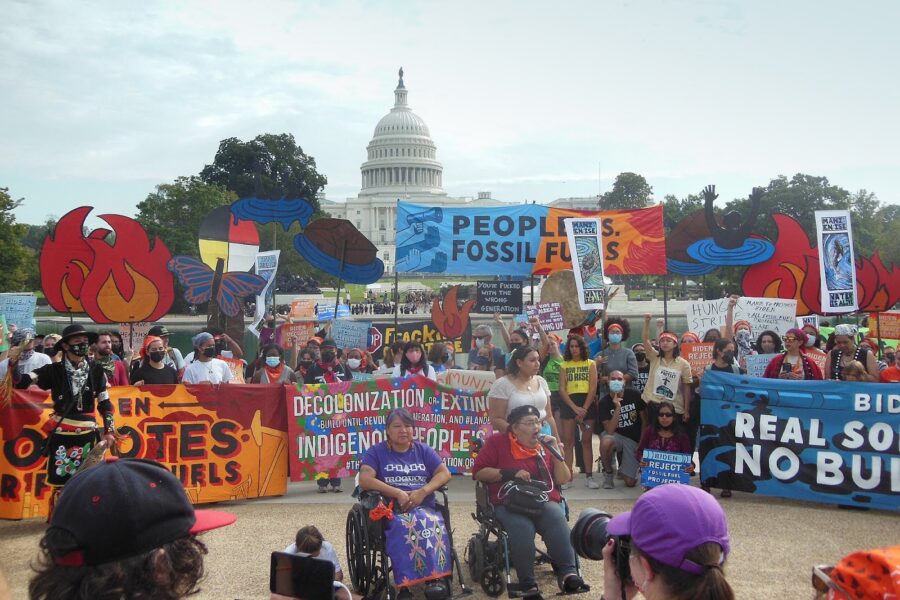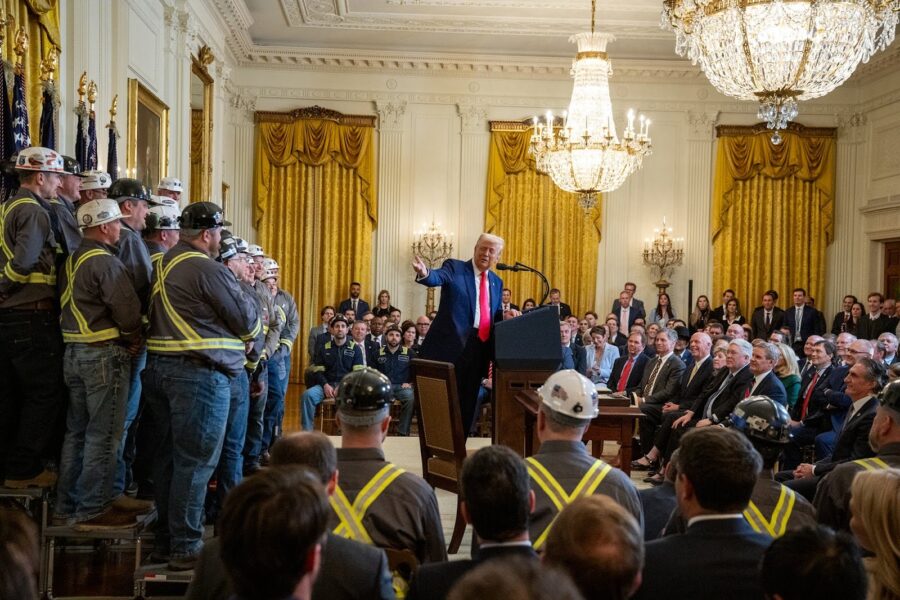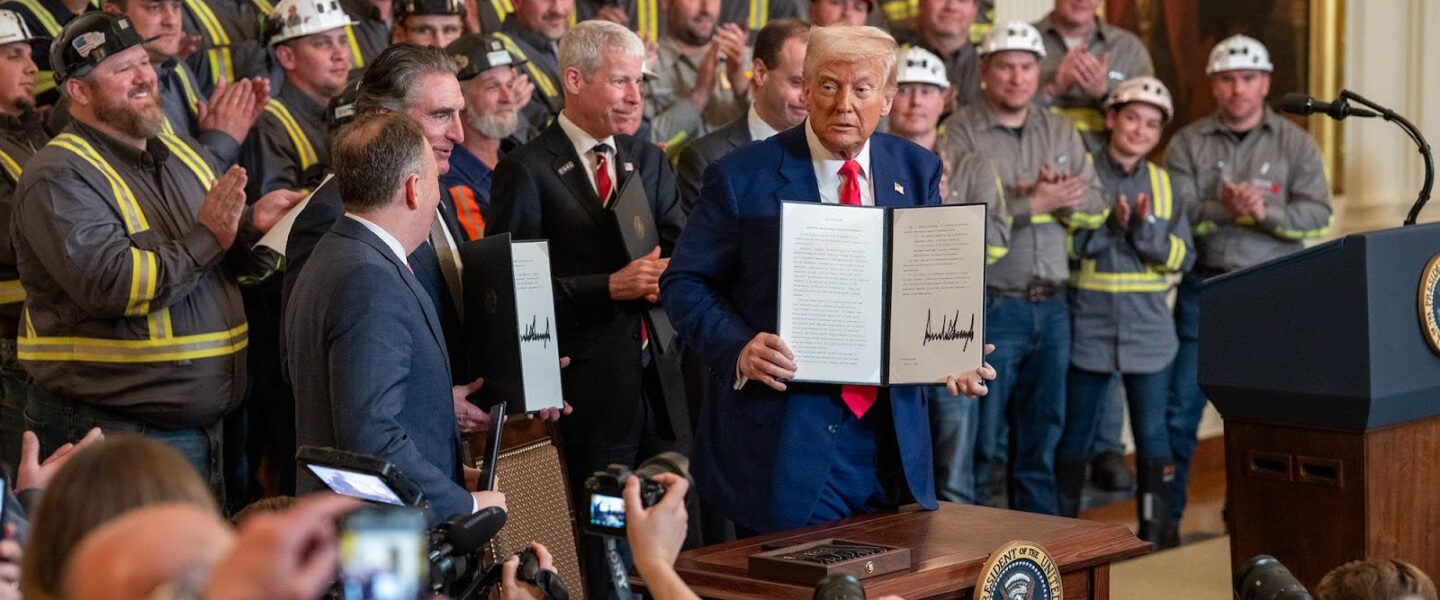In an executive order, President Trump instructed the Department of Justice to “stop the enforcement” of “unconstitutional” or “otherwise unenforceable” state climate laws. Earth.Org looks at what these laws mandate, and what states have them in place.
|
Listen To This Story
|
In an executive order, US President Donald Trump instructed the Department of Justice to “stop the enforcement” of what his administration says are “unconstitutional” or “otherwise unenforceable” state climate laws. It was one of four orders aimed at invigorating the coal industry, an industry in decline both in the US and globally.
The order instructs Attorney General Pam Bondi to “prioritize the identification” and “take all appropriate action to stop the enforcement” of state laws “purporting to address ‘climate change’ or involving ‘environmental, social, and governance’ initiatives, ‘environmental justice,’ carbon or ‘greenhouse gas’ emissions, and funds to collect carbon penalties or carbon taxes.”
It identifies California, New York, and Vermont as targets, alongside a wide array of state regulations that the administration aims to invalidate, spanning from cap-and-trade programs to licensing regulations. Trump says these laws are “fundamentally irreconcilable with my Administration’s objective to unleash American energy” and they “should not stand.”
In a joint statement, the two Democratic governors who co-chair the US Climate Alliance — Kathy Hochul of New York and Michelle Lujan Grisham of New Mexico — said states would not be deterred by the executive order.
“We will keep advancing solutions to the climate crisis that safeguard Americans’ fundamental right to clean air and water, create good-paying jobs, grow the clean energy economy, and make our future healthier and safer,” the statement read.
But what exactly do these climate laws mandate, and what states have them in place? Earth.Org takes a closer look.
‘Climate Superfund’ Bills
Lawmakers in New York and Vermont passed so-called “climate superfund” laws last year, while Maryland, Massachusetts, New Jersey, Oregon, Rhode Island, and Connecticut are considering similar legislation.
These laws seek to hold fossil fuel companies financially responsible for damage caused by the burning of three planet-warming fossil fuels — coal, oil and gas.
The concept of a “climate superfund” draws parallels to the Superfund program established by the Comprehensive Environmental Response, Compensation, and Liability Act (CERCLA) of 1980, which was created to clean up sites contaminated with hazardous substances.
These laws effectively extend the well-established “polluter pays” principle beyond traditional water, air, and land pollution to include greenhouse gas emissions, the primary drivers of global warming. Fossil fuels account for more than 75 percent of global greenhouse gases and nearly 90% of all carbon dioxide emissions.
On May 30, 2024, Vermont became the first US state to pass such a law.
It gives the state treasurer time until January 2026 to identify the overall expenses Vermont residents incurred due to greenhouse gas emissions between 1995 and 2024 — potentially billions of dollars. Vermont-based energy firms will then split the cost proportionally to their contribution to global emissions during that period.

Photo credit: Frypie / Wikimedia (CC BY-SA 4.0)
New York followed suit, passing the Climate Change Superfund Act in December. The law gives the New York State Department of Environmental Conservation time until December 2025 to identify responsible parties and determine their covered greenhouse gas emissions.
“New York has fired a shot that will be heard round the world: The companies most responsible for the climate crisis will be held accountable,” New York state Sen. Liz Krueger, a Democrat who co-sponsored the bill, said in a statement.
The law was amended in March, extending the covered emissions period from 2000-2018 to 2000-2024.
Similar to the CERCLA program, climate superfund laws propose the creation of a fund or mechanism to finance the cleanup and restoration of areas affected by climate-related disasters. They may involve provisions for funding research into climate change impacts, supporting renewable energy initiatives, enhancing infrastructure resilience, and providing aid to communities and individuals impacted by climate-related events.
New York’s law is expected to raise $75 billion over the next 25 years from fees, with one-third set to be allocated to disadvantaged communities.
California, which introduced its own version of climate superfund legislation in February, said the fees will go into a Polluters Pay Climate Fund to finance climate disaster recovery and resiliency projects.
The legislation came just weeks after devastating wildfires torched Los Angeles County, destroying more than 16,000 structures and claiming 29 lives. Researchers found that human-induced climate change has worsened the wildfires, increasing their likelihood by about 35 percent.
“The LA fires show with heartbreaking clarity how much we need this bill to make the biggest climate polluters pay for the astronomical damage they’ve caused,” said Kassie Siegel, director of the Center for Biological Diversity’s Climate Law Institute. “By passing this commonsense bill, state lawmakers can put the financial burden of climate damage on giant polluting companies, where it belongs.”
California’s Polluters Pay Climate Superfund Act requires companies generating more than 1 billion tons of greenhouse gas emissions between 1990 and 2024 to pay into the newly created state fund.
Legal Challenges
Energy companies are expected to initiate legal disputes against state-level climate bills, contending that they are overridden by federal regulations that govern energy firms and polluters.
This line of reasoning has been employed in an ongoing legal challenge spearheaded by the American Petroleum Institute and the US Chamber of Commerce against Vermont’s “polluters pay” legislation, which they view as an act of “excessive overreach” by states. They argue that the federal Clean Air Act already tackles the emissions outlined in the state law, thereby invalidating the Vermont legislation and deeming it unconstitutional.
New York’s bill is also facing two separate legal challenges, both which largely mirror the allegations made in the Vermont suit.

Photo credit: The White House / Flickr (PD)
The American Petroleum Institute, which represents oil and gas companies, celebrated the new order. “We welcome President Trump’s action to hold states like New York and California accountable for pursuing unconstitutional efforts that illegally penalize US oil and natural gas producers for delivering the energy American consumers rely on every day,” it said in a statement.
Other Laws Under Attack
But climate superfund bills are not the only climate laws targeted in Trump’s directive, which legal experts and activists have called “illegal” and “unconstitutional.”
The executive order calls out California’s cap-and-trade program, saying the state uses as a way to “punish carbon use” to meet its “radical” emissions reduction targets.
The program is a centerpiece of the state’s ambitious climate strategy. Adopted in 2013, it sets a cap on total greenhouse gas emissions and allows companies to buy and sell allowances – essentially “rights to pollute” — that can be traded in the market.
The monetization of emissions provides an additional incentive for firms to cut emissions: excess polluters can save costs by reducing emissions and buying fewer allowances, while firms that reduce emissions beyond their quota can profit by selling additional allowances in the market.
California’s program is linked with Quebec’s carbon market, creating a broader regional market for emissions reductions. Since its inception, it has appropriated more than $32 billion, which have been deposited into the California Greenhouse Gas Reduction Fund. Several studies have also linked the program to lower air pollution levels, particularly in disadvantaged communities and communities of color in California.
Twelve other states have similar trade programs for cutting emissions that find themselves targeted for elimination under Trump’s directive.
Legislation requiring all electricity to derive from carbon-free energy sources like wind and solar, which is currently in place in Michigan, Colorado, and Minnesota, are also under scrutiny.
This story by Martina Igini was originally published by Earth.Org and is part of Covering Climate Now, a global journalism collaboration strengthening coverage of the climate story. WhoWhatWhy has been a partner in Covering Climate Now since its inception in 2019.





